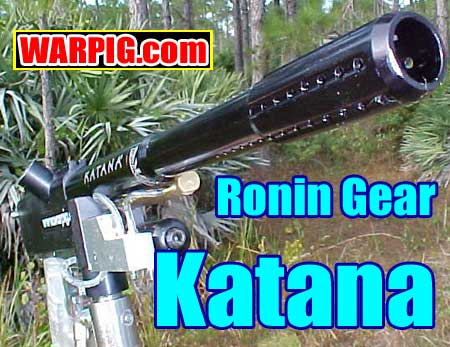  |
|
|
|
|
|
|
  |
|
|
|
|
|
|

What
do you think?
|

Ronin Gear Katana Barrel By WARPIG.com Technical Editor, Bill Mills The press release for the Katana barrel from Ronin Gear read as follows “This is the most sophisticated paintball delivery system ever designed! Unique, patented 'twist & click' sizing system, which allows you to instantly change the size of the bore, without any disassembly whatsoever! No more changing sleeves, inserts, or barrel backs! The Bore-sizing system works by using a patented collapsible inner sleeve with 5 external settings for optimal ball to barrel fit. Bore settings are set at .676, .680, .684, .688, and .692.” When the press release came out, someone e-mailed me to ask if the Katana was a knock off of Psychoballistics’ Aradus adjustable barrel, so I called Ronin Gear distributor, I&I Sports, to get the story. Like a lot of companies in paintball, Ronin Gear sub-contracts much of their manufacturing, and I learned that the similarities in the Ronin and Psychoballistics barrels stem from the fact that Psychoballistics makes them both. These barrels operate on the premise that paint to barrel size matching is important. Rather than changing barrels to get a match, or swapping out different sized inserts, the Katana has an internal sleeve that can be adjusted in diameter.
As the outer sleeve is rotated, the inner sleeve is compressed. Viewed from the end the inner sleeve is a nearly closed “C” shape. It is the small gap in the “C” that gives room for the sleeve to be compressed. At the largest diameter setting, this gap is approximately 1/16inch and at the smallest, it is approximately 1/64inch.
Also included with the barrel is a lock ring. This red ring slides over the barrel and has a pair of set screws, the hex wrench for which is also included. The ring can be slid to either the front of back of the outside adjuster sleeve and used to lock it in place. This is because changing the barrel can effect velocity, and paintball tournaments, as well as most paintball fields, will require that paintguns be locked so that velocity can not be adjusted on the field.
At the chrono, with DraXxus Blaze paint, adjusting the barrel definitely made a difference in performance. The .684 and .688 settings both worked well, while there was a velocity drop off at .692 and .680 .676. It was a fast process to dial in the barrel to get the most gas efficiency for the paint being used. While accuracy observations are very subjective, and very dependant on the quality of the particular batch of paint used, the Katana seemed on par with most after market barrels, and appeared to shoot tighter shot groupings with the test paint at 0.684 than at the overbore 0.692 setting. While one might expect that the ridges, and the expansion gap in the inner sleeve would cause poor accuracy, this did not appear to be the case. The Katana is a different twist on paint to barrel matching, and gives the versatility of matching a bore size to optimize gas efficiency without the extra baggage of different barrels or inserts. The fit of the Katana’s lock ring to the Autococker pneumatics is important and a good reason to consider purchasing from a local dealer where the fit can be tested prior to purchase.
|
| Copyright © 1992-2019
Corinthian Media Services. WARPIG's webmasters can be reached through our feedback form. All articles and images are copyrighted and may not be redistributed without the written permission of their original creators and Corinthian Media Services. The WARPIG paintball page is a collection of information and pointers to sources from around the internet and other locations. As such, Corinthian Media Services makes no claims to the trustworthiness or reliability of said information. The information contained in, and referenced by WARPIG, should not be used as a substitute for safety information from trained professionals in the paintball industry. |